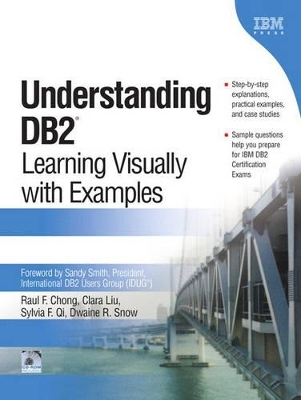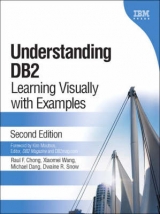
Understanding DB2
IBM Press
978-0-13-185916-6 (ISBN)
- Titel erscheint in neuer Auflage
- Artikel merken
The Easy, Visual Guide to IBM DB2 V8.2
IBM DB2 Universal Database™ V8.2 for Linux®, UNIX®, and Windows® is a flexible, scalable, cost-effective, and easy-to-use enterprise database. Now, one book makes DB2 even easier. Understanding DB2 teaches DB2 V8.2 visually, step by step, with dozens of examples and case studies drawn from the authors' unsurpassed experience as DB2 consultants at IBM.
Understanding DB2 doesn't just present the big picture. It thoroughly introduces every DB2 concept, procedure, and tool you'll need to get results as an administrator, user, or developer. You'll find authoritative coverage of installation, configuration, objects, database instances, storage, connectivity, security, performance, backup and recovery, SQL fundamentals, and much more. Virtually every new concept is explained with screenshots, diagrams, or tables, all designed to help you learn faster and remember more.
For those preparing for certification, this book also contains over a hundred sample questions crafted by the authors to reflect the content and format of the IBM DB2 UDB Database Administration Certification exams, with answers and detailed explanations.
Coverage includes
Understanding the DB2 product family, DB2 commands, and the DB2 environment
Configuring client and server connectivity: walkthroughs of four typical scenarios
Managing DB2 storage: partitions, tablespaces, buffer pools, and more
Leveraging the power of SQL: queries, inserts, deletes, and updates
Implementing security: encryption, authentication, and authorization
Administering and maintaining data, from LOAD and EXPORT to backup/recovery
Providing high availability with online split mirroring and suspended I/O
DB2 architecture: process and memory models
Managing database performance and troubleshooting
Raul F. Chong is a DB2 information developer with the Application Development Solutions team at the IBM Toronto Lab. He is responsible for developing sample programs and DB2 documentation for Web Services and CLI. Clara Liu is a database consultant at the IBM Toronto Lab. She works with a variety of IBM partners and customers on projects utilizing DB2 Universal Database. Sylvia F. Qi has worked with DB2 UDB as a DB2 service analyst for IBM since 1999. A contributing author to IBM developerWorks®, she has in-depth knowledge of the DB2 engine, connectivity, and administration. Dwaine R. Snow is a senior product manager for DB2 UDB for Linux, UNIX, and Windows. He has worked with DB2 UDB for the past fourteen years as part of the development team focusing on the database engine and tools, and the development of the DB2 Certification program.
Foreword xxiPreface xxiiiAcknowledgments xxviiAbout the Authors xxixChapter 1 Introduction to DB2 UDB 11.1 A Brief History of DB2 1
1.2 DB2 software and the IBM E-Business On-Demand Model 4
1.3 DB2 UDB Editions 5
1.4 DB2 UDB Clients 11
1.5 "Try and Buy" Versions 13
1.6 Host Connectivity 13
1.7 Federated Support 14
1.8 Replication Support 14
1.9 IBM DB2 Information Integrator 15
1.10 Special Package Offerings for Developers 15
1.11 DB2 Syntax Diagram Conventions 17
1.12 Case Study 18
1.13 Summary 20
1.14 Review Questions 21
Chapter 2 DB2 at a Glance: The Big Picture 232.1 SQL Statements and DB2 Commands 24
2.2 DB2 Tools Overview 27
2.3 The DB2 Environment 29
2.4 Federation 42
2.5 Case Study: The DB2 Environment 44
2.6 Database Partitioning Feature 45
2.7 Case Study: DB2 with DPF Environment 61
2.8 Summary 66
2.9 Review Questions 67
Chapter 3 Installing DB2 713.1 DB2 Installation: The Big Picture 71
3.2 Required User IDs and Groups 72
3.3 Installing DB2 Using the DB2 Setup Wizard 77
3.4 Silent Install Using a Response File 92
3.5 Installing DB2 Manually (Linux/UNIX Only) 96
3.6 Installing a DB2 License 97
3.7 Installing DB2 in a DPF Environment 99
3.8 Installing DB2 FixPaks 100
3.9 Case Study 102
3.10 Summary 104
3.11 Review Questions 105
Chapter 4 Using the DB2 Tools 1074.1 DB2 Tools: The Big Picture 107
4.2 The Command Line Tools 108
4.3 Development Tools 126
4.4 General Administration Tools 129
4.5 Information Tools 134
4.6 Monitoring Tools 136
4.7 Setup Tools 141
4.8 Other Tools 142
4.9 Tool Settings 146
4.10 Case Study 147
4.11 Summary 150
4.12 Review Questions 150
Chapter 5 Understanding the DB2 Environment, DB2 Instances, and Databases 1535.1 The DB2 Environment, DB2 Instances, and Databases: The Big Picture 153
5.2 The DB2 Environment 154
5.3 The DB2 Instance 160
5.4 The Database Administration Server 177
5.5 Configuring a Database 178
5.6 Instance and Database Design Considerations 185
5.7 Case Study 186
5.8 Summary 188
5.9 Review Questions 189
Chapter 6 Configuring Client and Server Connectivity 1936.1 Client and Server Connectivity: The Big Picture 193
6.2 The DB2 Directories 195
6.3 Supported Connectivity Scenarios 205
6.4 Configuring Database Connections Using the Configuration Assistant 220
6.5 Case Study 238
6.6 Summary 239
6.7 Review Questions 241
Chapter 7 Working with Database Objects 2437.1 DB2 Database Objects: The Big Picture 243
7.2 Databases 246
7.3 Partition Groups 251
7.4 Table Spaces 252
7.5 Buffer Pools 254
7.6 Schemas 254
7.7 Data Types 256
7.8 Tables 262
7.9 Indexes 285
7.10 Multidimensional Clustering Tables and Block Indexes 291
7.11 Views 295
7.12 Packages 301
7.13 Triggers 301
7.14 Stored Procedures 303
7.15 User-Defined Functions 306
7.16 Sequences 308
7.17 Case Study 309
7.18 Summary 312
7.19 Review Questions 312
Chapter 8 The DB2 Storage Model 3178.1 The DB2 Storage Model: The Big Picture 317
8.2 Databases: Logical and Physical Storage of Your Data 319
8.3 Database Partition Groups 327
8.4 Table Spaces 331
8.5 Buffer Pools 354
8.6 Case Study 358
8.7 Summary 360
8.8 Review Questions 360
Chapter 9 Leveraging the Power of SQL 3659.1 Querying DB2 Data 365
9.2 Modifying DB2 Data 379
9.3 Selecting from UPDATE, DELETE, and INSERT 380
9.4 The MERGE Statement 382
9.5 Recursive SQL 383
9.6 The UNION, INTERSECT, and EXCEPT Operators 384
9.7 Case Study 387
9.8 Summary 390
9.9 Review Questions 390
Chapter 10 Implementing Security 39710.1 DB2 Security Model: The Big Picture 397
10.2 Authentication 398
10.3 Data Encryption 411
10.4 Administrative Authorities 411
10.5 Database Object Privileges 417
10.6 Authority and Privilege Metadata 427
10.7 Windows Domain Considerations 432
10.8 Case Study 434
10.9 Summary 436
10.10 Review Questions 436
Chapter 11 Understanding Concurrency and Locking 43911.1 DB2 Locking and Concurrency: The Big Picture 439
11.2 Concurrency and Locking Scenarios 440
11.3 DB2 Isolation Levels 443
11.4 Changing Isolation Levels 449
11.5 DB2 Locking 455
11.6 Diagnosing Lock Problems 465
11.7 Techniques to Avoid Locking 479
11.8 Case Study 480
11.9 Summary 481
11.10 Review Questions 482
Chapter 12 Maintaining Data 48512.1 DB2 Data Movement Utilities: The Big Picture 485
12.2 Data Movement File Formats 486
12.3 The DB2 EXPORT Utility 488
12.4 The DB2 IMPORT Utility 496
12.5 The DB2 LOAD Utility 502
12.6 The db2move Utility 522
12.7 The db2relocatedb Utility 523
12.8 Generating Data Definition Language 524
12.9 DB2 Maintenance Utilities 526
12.10 Case Study 531
12.11 Summary 533
12.12 Review Questions 533
Chapter 13 Developing Database Backup and Recovery Solutions 53713.1 Database Recovery Concepts 537
13.2 DB2 Transaction Logs 540
13.3 Recovery Terminology 551
13.4 Performing Database and Table Space Backups 552
13.5 Database and Table Space Recovery Using the RESTORE DATABASE Command 558
13.6 Database and Table Space Roll Forward 563
13.7 Recovering a Dropped Table 567
13.8 The Recovery History File 568
13.9 Database Recovery Using the RECOVER DATABASE Command 569
13.10 High Availability Through Online Split Mirroring and Suspended I/O Support 570
13.11 High Availability Disaster Recovery 574
13.12 Using DB2 Tools to Inspect the Health of Your Database 582
13.13 Case Study 584
13.14 Summary 587
13.15 Review Questions 588
Chapter 14 The DB2 Process Model 59314.1 The DB2 Process Model: The Big Picture 593
14.2 The DB2 Engine Dispatchable Units 596
14.3 Tuning the Number of EDUs 608
14.4 Monitoring and Tuning the DB2 Agents 609
14.5 The Connection Concentrator 611
14.6 Commonly Seen DB2 Executables 612
14.7 Additional Services/Processes on Windows 612
14.8 Case Study 613
14.9 Summary 615
14.10 Review Questions 616
Chapter 15 The DB2 Memory Model 61915.1 DB2 Memory Allocation: The Big Picture 619
15.2 Instance-Level Shared Memory 621
15.3 Database-Level Shared Memory 623
15.4 Application-Level Shared Memory 627
15.5 Agent-Level Private Memory 629
15.6 The Memory Model 632
15.7 32-Bit Memory Model Considerations 632
15.8 64-Bit Memory Model Considerations 634
15.9 AWE Support with Windows 634
15.10 Case Study 635
15.11 Summary 639
15.12 Review Questions 639
Chapter 16 Database Performance Considerations 64316.1 Performance Fundamentals 644
16.2 System/Server Configuration 644
16.3 The DB2 Configuration Advisor 646
16.4 Configuring the DB2 Instance 654
16.5 Configuring Your Databases 657
16.6 Lack of Proper Maintenance 663
16.7 The Snapshot Monitor 666
16.8 Event Monitors 669
16.9 The DB2 Optimizer 672
16.10 The Explain Tool and Explain Tables 673
16.11 Using Visual Explain to Examine Access Plans 675
16.12 Case Study 676
16.13 Summary 680
16.14 Review Questions 680
Chapter 17 Diagnosing Problems 68317.1 Problem Diagnosis: The Big Picture 683
17.2 How Does DB2 Report Problems? 684
17.3 DB2 Error Message Description 686
17.4 DB2 First-Failure Data Capture 687
17.5 Receiving E-mail Notifications 692
17.6 The db2support Tool 693
17.7 The DB2 Trace Facility 694
17.8 Searching for Known Problems 694
17.9 Case Study 695
17.10 Summary 696
17.11 Review Questions 696
Appendix A Solutions to the Review Questions 699Appendix B Use of Uppercase Versus Lowercase in DB2 721Appendix C IBM Servers 723Appendix D Using the DB2 System Catalog Tables 725Appendix E Setting Up Database Connectivity for DB2 UDB for z/OS and DB2 UDB for iSeries 739Appendix F Diagnosing DB2 Connectivity Problems 771Resources 779Glossary 785Index 851About the CD-ROM 897
| Erscheint lt. Verlag | 3.2.2005 |
|---|---|
| Verlagsort | Armonk |
| Sprache | englisch |
| Maße | 187 x 244 mm |
| Gewicht | 1542 g |
| Themenwelt | Informatik ► Datenbanken ► DB2 |
| ISBN-10 | 0-13-185916-1 / 0131859161 |
| ISBN-13 | 978-0-13-185916-6 / 9780131859166 |
| Zustand | Neuware |
| Informationen gemäß Produktsicherheitsverordnung (GPSR) | |
| Haben Sie eine Frage zum Produkt? |
